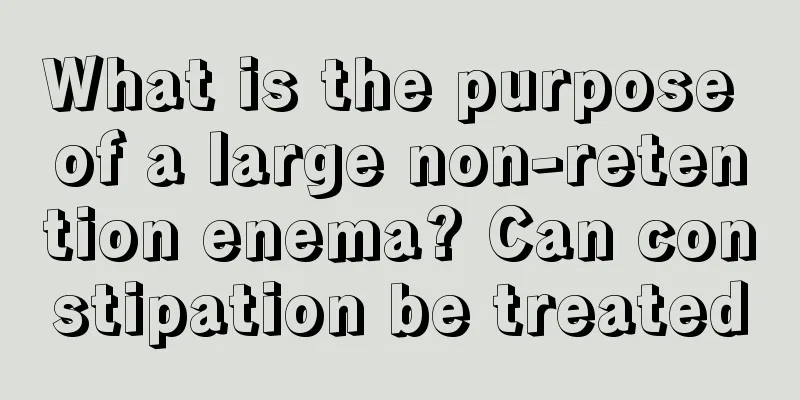What is the purpose of a large non-retention enema? Can constipation be treated

|
The main purpose of large-volume non-retaining enema is to help patients digest, clean gastrointestinal function, soften stool, promote stool metabolism, and relieve abdominal distension and diarrhea. However, everyone needs to pay attention that before doing this operation, you can go to the hospital for a physical examination first, and according to the doctor's instructions, it can be performed once in the hospital. If there is no professional in this area at home, you can also do it yourself at home, but you must keep it clean and hygienic to prevent infection. Purpose of a large non-retention enema Purpose of large non-retaining enemas Complications of large non-retaining enemas The purpose of a large number of non-retention enemas can be summarized in four points. The first is to stimulate intestinal peristalsis, soften and clean feces, expel gas trapped in our intestines, and relieve the patient's abdominal distension. The second purpose is to clean the intestines and prepare for subsequent surgery, examination or delivery. The third purpose is to dilute and remove some harmful substances in the intestines and relieve the patient's poisoning symptoms. The fourth purpose is to reduce the temperature of patients with high fever. Large-volume no-retention enema method Purpose of large non-retaining enemas Complications of large non-retaining enemas Dress decently and neatly, wash hands and wear a mask. Prepare the supplies, check the expiration dates of the items, and prepare the enema solution according to the doctor's instructions. The enema solution is generally 0.1%-0.2% soapy water or saline (temperature 39-41°C). Liquid volume: 800-1000 ml for adults, 200-500 ml for children. After checking, the two of them brought the items to the bedside. ① Check the patient’s bedside card and name. Assess the patient's physical condition and bowel movements. ② Explain the purpose of the operation and ask the patient to defecate and urinate. ③ Adjust the height of the infusion stand (40-60 cm from the patient's anus to the liquid level in the enema bag) ④ Check the validity period of the enema bag and whether the packaging is damaged, open the enema bag and close the adjustment clip of the enema bag, pour the prepared enema solution into it, hang the enema bag on the infusion stand, and exhaust the air for the first time about 10CM away from the anal tube head (same as the infusion exhaust method), clamp it with hemostatic forceps and hang it on the infusion stand (Note: Wrap the tube with gauze first and then clamp it with forceps.) ⑤Close doors and windows to shield the patient. Move the pillow towards the operator, assist the patient to assume left side lying position, take off the pants to the knees (cover the patient's chest, back and lower limbs with a quilt), expose the patient's buttocks, move the buttocks to the edge of the bed, bend both knees (the elderly can lie on their backs with a bedpan under their buttocks), and place a disposable diaper under their buttocks. Place one end of the anal canal in the curved disc. (You can also put one end of the anal tube on the enema bag) ⑥Prepare 4 pieces of toilet paper and place them on the diaper. Purpose of large non-retaining enemas Complications of large non-retaining enemas Infusion : ①Wear gloves. ② Take gauze and apply vaseline or liquid paraffin oil, lubricate the front end of the anal canal of the enema bag, and then lubricate the anus. ③ Vent the anal canal for the second time to remove the gas in the anal canal (put the liquid into the curved plate when venting the gas), and clamp the anal canal with hemostatic forceps. ④ Use your left hand to take some toilet paper and separate your buttocks to expose your anus. ⑤ Ask the patient to take a deep breath, hold the anal tube in the right hand and gently insert it into the rectum according to the anatomical characteristics (the hard tube needs to be moved forward first and then backward) 10-15 cm. ⑥ Fix the anal canal with your left hand, loosen the regulating valve or hemostatic forceps with your right hand, and ask the patient to take a deep breath to allow the solution to flow in slowly. observe : ①Control the flow rate and observe the patient's reaction. ② When the urge to defecate occurs, slow down the flow rate or lower the enema bag, and ask the patient to breathe through the mouth (to reduce abdominal pressure). After filling : ① When the liquid runs out, close the regulating valve or hemostatic forceps. ② Press your left hand against your anus, and use your right hand to take some toilet paper and wrap it around the anal canal, bend the anal canal, and slowly pull it out. ③Discard the enema bag into a medical waste bag. ④ Use toilet paper to clean the anus, and remove the curved tray and diaper. Take off your gloves. ⑤ Ask the patient or help the patient lie down, tidy up the patient's clothes, and ask the patient to retain it for 5-10 minutes (to soften the stool). Patient's bowel movement : Arrange items : Make the bed after the patient has defecated, observe the stool, and collect samples if necessary; open windows for ventilation; handle items; wash hands and keep records. |
<<: Who should not use small-volume non-retention enema?
>>: Can enema really cleanse the intestines?
Recommend
How can people who love to eat salted fish prevent nasopharyngeal cancer
In life, although many people know that eating to...
Can yam and black beans be eaten together
Yam is a common food with high nutritional value....
The best treatment for prostate cancer at 70 years old
The specific cause of prostate cancer is still un...
Farting with thick liquid and blood
There is a scientific reason why diseases come fr...
What can I use to wash my hands to kill the bacteria on my hands
There are a lot of bacteria on people's hands...
What should pregnant women pay attention to when caring for colorectal cancer
Colorectal cancer is one of the more common malig...
Is it necessary to get the leprosy vaccine?
Among the many types of vaccines, leprosy vaccine...
Can you eat red grapefruit peel?
Pomelo is a kind of fruit that many people like t...
What should I do if I have sciatica?
I believe that most of my friends are not so unfa...
Which is better for a hot or cold shower
Bathing is one of the basic elements of personal ...
What is the treatment and care for testicular cancer
Because of the special location of the testicles ...
Symptoms of lumbar muscle strain, acute and chronic
Muscle strain is caused by excessive traction on ...
Nursing measures for breast cancer
After breast cancer surgery, postoperative care n...
What's wrong with a girl's delayed menarche?
Menstrual period is a necessary stage in a girl’s...
What Chinese medicine is effective for advanced gastric cancer
What Chinese medicine is effective for advanced g...









